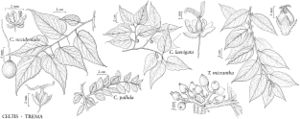Difference between revisions of "Trema micrantha"
Mus. Bot. 2: 58. 1856.
imported>Volume Importer |
imported>Volume Importer |
||
| Line 83: | Line 83: | ||
|publication year=1856 | |publication year=1856 | ||
|special status=W1;Illustrated | |special status=W1;Illustrated | ||
| − | |source xml=https:// | + | |source xml=https://bitbucket.org/aafc-mbb/fna-data-curation/src/2e0870ddd59836b60bcf96646a41e87ea5a5943a/coarse_grained_fna_xml/V3/V3_523.xml |
|genus=Trema | |genus=Trema | ||
|species=Trema micrantha | |species=Trema micrantha | ||
Latest revision as of 21:49, 5 November 2020
Shrubs to small trees, 2-5.5(-10) m. Bark dark brown, smooth when young, developing small, warty projections in maturity. Branchlets copiously pubescent. Leaf blade ovate to narrowly ovate, 5-6.5(-9) × 2.5-4(-4.5) cm, base oblique to cordate, margins evenly serrate, apex acute to long-acuminate; abaxial surface softly, velvety white-pubescent; venation conspicuous but scarcely raised. Flowers: calyx greenish white. Fruits bright red-orange to yellow, 1.5-3.5 mm diam. 2n = 20 (from Costa Rica).
Phenology: Flowering most of year (Mar–Nov).
Habitat: Hammocks and prairies, often weedy along roadsides, in burned areas, and on calcareous ground
Elevation: 0-100 m
Distribution

Fla., Mexico, West Indies, Central America, South America.
Discussion
Trema micrantha, as interpreted here, is widespread in tropical regions of the New World. Small-leaved populations may be confused with T. lamarckiana.
The soft wood of Trema micrantha is suitable for the construction of tea chests and match sticks.
Selected References
None.
